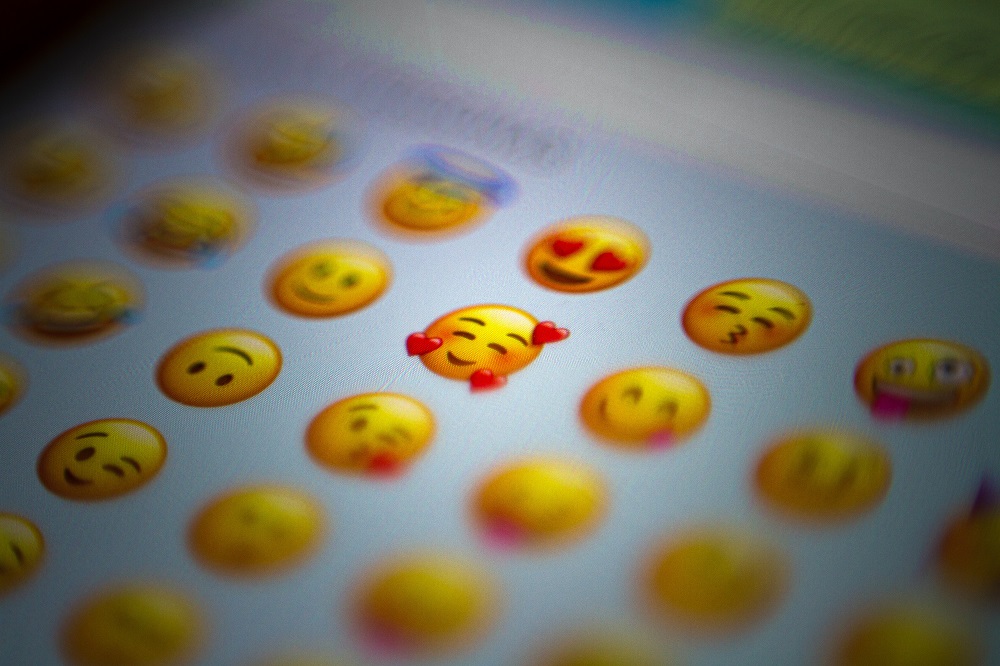For many, the emoji is used to support their text, giving hints as to the tone of their voice or to secure the meaning behind the content they use.
Despite emojis being a universal form of communication, there are often multiple meanings for one emoji or misunderstandings on how it should be interpreted. To find out more about the multiple meanings to emojis and how they are used in the UK, we surveyed 1,000 people on their communication habits this year.
What do people use emojis for?
When asked what they use emojis for, the research showed over four-fifths of Brits use emojis to text their friends. The second highest result was family members, where over three-quarters are using emojis to get in touch with their family via text.
| What do you use emojis for? | Percentage of respondents |
| Texting friends | 84.20% |
| Texting family members | 76.70% |
| Texting colleagues | 32.70% |
| Emailing colleagues | 8.70% |
| I don’t use emojis | 7.10% |
| Emailing clients/business partners | 2.80% |
The research showed emojis are becoming a larger part of our working life, too, with one in three using emojis when they are texting their colleagues. Almost one in ten Brits use emojis when emailing colleagues, but just three in every 100 admit to using emojis when emailing clients or business partners, demonstrating that emojis haven’t filtered into every part of our lives just yet.
What is the most commonly used emoji?
We asked Brits what their three most used emojis were to find out which we cannot live without to communicate with day-to-day.
The most used emoji face is the face with tears of joy, otherwise known as the laughing face, with almost half of respondents reporting this as their top emoji. This was accompanied by number four, the loudly crying emoji, which has overwhelmingly been used to share positivity in recent years as younger generations claim this as their preferred laughing emoji.
Next in line is the smiling face with smiling eyes face emoji, which a quarter of Brits called as one of their top three emojis. This was closely followed by the heart emoji which is used to express love, positive feelings, and gratitude. Making it into the top 10 were also the face blowing a kiss and heart eye emoji which can be used in a similar vein.
| Rank | Emoji | Percentage of respondents |
| 1 | Face with tears of joy (laughing) | 45.60% |
| 2 | Smiling face with smiling eyes | 25.90% |
| 3 | Red Heart | 19.80% |
| 4 | Loudly crying face | 15.60% |
| 5 | Thumbs up | 13.40% |
| 6 | Grinning face (happy) | 8.70% |
| 7 | Face blowing a kiss | 7.80% |
| 8 | Disappointed face (sad) | 7.20% |
| 9 | Smiling face with heart eyes | 5.00% |
| 10 | Winking face | 4.60% |
In the tenth spot was the winking face, with just 4.6% of respondents naming this as one of their top three emojis.
What does this emoji mean?
While each emoji has a standard meaning behind it, they do not always get used in the way their creators intended them. Here, we have come up with a list of the six most often misused emojis.
1. Upside Down Smiley

This emoji is meant to convey sarcasm, irony, humour, and silliness. It can represent awkwardness or frustration, where someone might use it instead of typing “oh well”, or “that’s annoying”.
The top answer for this emoji was that it represents something happy and should be used in circumstances of happiness. This demonstrates that many Brits are in fact using this emoji in the wrong instance!
The second most popular answer for this emoji was that it represents confusion and the third that it should be used to represent sarcasm, showing some respondents were aware of the intended use.
2. Information Desk Person

While our survey showed the majority of Brits are using this emoji to say ‘hi’, ‘whatever’ or show ‘sass’, this is not its true intention.
The emoji is, in fact, intended to represent a person at an information or reception desk who can aid individuals with answers to their questions.
3. Slightly Smiling Face

This emoji is a yellow face with a thin closed smile and open eyes. The tone of the emoji can often be used to emphasise a passive aggressive message or something ironic, where the sender means to communicate that something is not really fine.
Our research showed that six in 10 Brits were not aware of this meaning, describing it as a ‘happy’ emoji. A further 23% stated that the aim of the emoji was to convey a smile while just 1.5% of respondents correctly responded that the emoji is used to mostly relay sarcasm.
4. Face with Steam from Nose

Over half of respondents correctly answered that this emoji is meant to demonstrate anger, with the furrowed eyebrows and steam blowing from the nose giving indications of irritation and frustration.
Answers also included describing the emoji as annoyed, however, some respondents incorrectly identified the emoji as portraying an image of an individual sneezing.
5. Grimacing

This emoji aims to represent negative or tense emotions, where an individual may be conveying nervousness, awkwardness or embarrassment.
Our research revealed that Brits are highly confused over the meaning of this emoji, with the top answer suggesting this emoji represents someone scared, and the fourth most popular answer being to show someone is cold.
While 16% of respondents did correctly identify the emoji as showing someone scared or nervous, others thought the clenched teeth were implying that this emoji is to represent anger.
While our research shows the importance of emojis in communicating day-to-day with friends, family and even colleagues, it also shows the confusion Brits can face when translating the meaning of a symbol in their head.
If you’d like help building or optimising your SMS Marketing campaigns or customer communications, speak to one of our experts today on +44 161 359 3100 or email [email protected].


